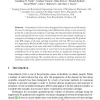1262 search results - page 241 / 253 » Face Recognition Using Active Appearance Models |
COGSCI
2004
13 years 8 months ago
2004
Previous research suggests that children can infer causal relations from patterns of events. However, what appear to be cases of causal inference may simply reduce to children rec...
UMUAI
1998
13 years 8 months ago
1998
This paper presents some alternate theories for explaining the term ‘initiative’, as it is used in the design of mixed-initiative AI systems. Although there is now active resea...
MICCAI
2004
Springer
14 years 9 months ago
2004
Springer
Osteoarthritis (OA) involves changes in the composition and ultimately the loss of cartilage from articulating joints. MRI has the ability to non-invasively probe the compositional...
CHI
2004
ACM
14 years 9 months ago
2004
ACM
Facial affect (or emotion) recognition is a central issue for many VMC and naturalistic computing applications. Most computational models assume "categorical perception"...
KDD
2010
ACM
14 years 12 days ago
2010
ACM
The security demands on modern system administration are enormous and getting worse. Chief among these demands, administrators must monitor the continual ongoing disclosure of sof...


